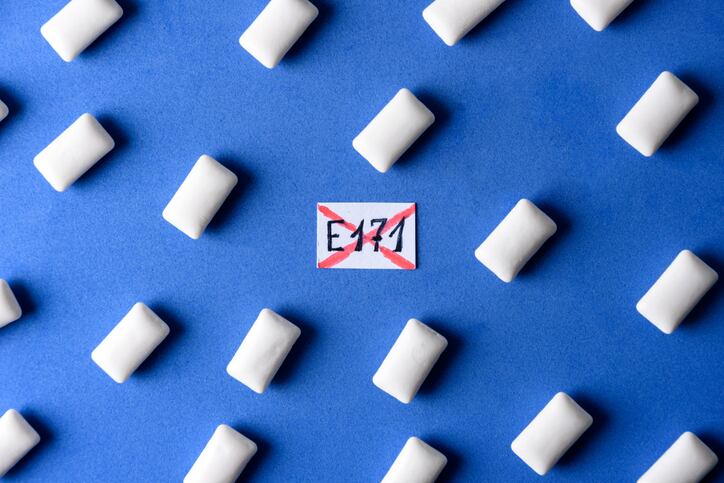EU Member States earlier this week approved the European Commission’s proposal to prohibit E171 as a food additive, meaning a ban on the controversial colourant is likely to come into force in early 2022.
The move to ban E171 follows an updated safety assessment from EFSA, which concluded ‘titanium dioxide can no longer be considered safe as a food additive’ in May. At the time, the food safety experts said they could not rule out genotoxicity concerns. The ingredient was also banned in France in 2020.
Titanium dioxide is currently used as a colorant in a number of products such as chewing gum, pastries, food supplements, soups and broths. But the ingredient has been linked to negative health consequences, including damage to the intestinal flora and – when ingested in the form of very small nanoparticles – the development of cancer.
Speaking to FoodNavigator before this week’s decision in Brussels, ingredient supplier Ingredion Incorporated revealed that end consumers are rejecting titanium dioxide, with major retailers in Europe already no longer allowing products that contain titanium dioxide on shelves. In Ingredion’s consumer surveys, 70% say they don't want to see titanium dioxide on labels.
“We are getting more inquiries from our customers to ask what is the alternative that you can offer us,” Constantin Drapatz, Ingredion Senior Marketing Manager Clean & Simple Food Ingredients EMEA told us.
It's not only in developed markets where the trend has moved against titanium dioxide, added Esra Akmanli Business Development Manager, Platforms, Europe at Ingredion. "We also see it in emerging markets like Turkey. In our consumers studies we see the desire for clean label is even higher in the emerging markets because these products are less available than in developed markets.”
All this means the industry faces the technical challenge of finding replacement solutions to E171. “Titanium dioxide is a very unique material,” said Drapatz. “It has a very small particle size. It's very robust. It does not deteriorate. Our customers at the moment are concerned about the next best alternative but we need to work very hard to get a similar end-functionality.”
Although it will be “working toward replacing titanium dioxide in more applications than we cannot do today,” according to Drapatz, the company’s efforts surrounding E171 replacement typically centre around carbohydrate-based ones such as rice starch and rice flour.
Like-for-like replacements are hard to find
The pro here is that rice as a base material is usually well accepted by consumers. The main challenge, however, is the fact titanium dioxide is used in a host of applications, meaning there’s rarely one like-for-like replacement.
“Very often when you're trying to replace an ingredient it's never a 1-2-1 match,” said Drapatz. “There are different solutions for different applications because titanium dioxide is very unique, and you might need different products to replace it. It's not going to be possible to find a one-on-one product that does exactly the same but potentially safer.”
For example, titanium dioxide’s great draw is its opacity, which it keeps after heating, and its characteristic bright white colour.
Rice and flour starch might fit one application very well as a direct replacement – such as chewing gum, coated applications and low-fat dairy. But in other applications more ingredients including emulsifiers, concentrates and purees might be needed to replace E171’s unique functionality.
"In general, when you're trying to replace titanium dioxide it's all about the opacity,” explained Drapatz. “Either the product is not as opaque anymore, so you have a more translucent product. Therefore, colours don't shine, or the product isn't as white and therefore a little bit artificial. Another concern is that if you're overdosing with a new ingredient, you’re completely changing the product. If you have, say, a creamy custard filling in a pastry, suddenly it's a gummy brick because you're trying to get the opacity, but you can only do that by adding so much more product.”
He continued: "If you think of a full fat versus a no fat milk: no fat is less opaque. Therefore, you could also use fat or a protein to replace titanium dioxide, but you can't do that in every application. It's also very costly to do that and it changes the properties of the product.
“The challenge is that it's not a cookie cutter approach. It's really depending on the application.”
Will costs rise after E171 ban?
Reformulating away from using titanium dioxide therefore might bring extra costs for manufacturers, admitted Akmanli. “But we also know consumers are ready to pay higher for the sake of cleaner labels,” she pointed out.
“Our surveys with manufacturers show that those who have converted to a clean label strategy had to increase prices. But they also confirmed that when they increase prices in line with the costs they could sell even more, and their margins were higher.”
Drapatz added: "In general, people are willing to pay more for a healthier, more recognisable product. So that's something manufacturers can benefit from. And from our perspective, flour and starch solutions are still far cheaper than, for example, a full fat or high protein alternative. Those ingredients are at least double per kilo.”



